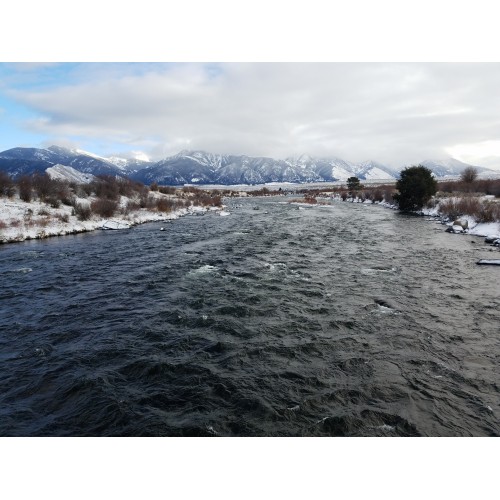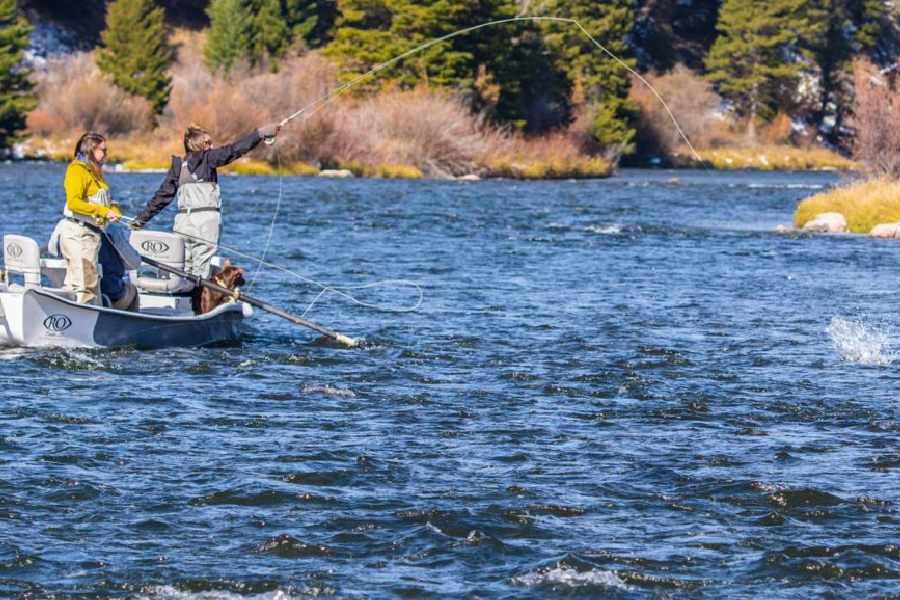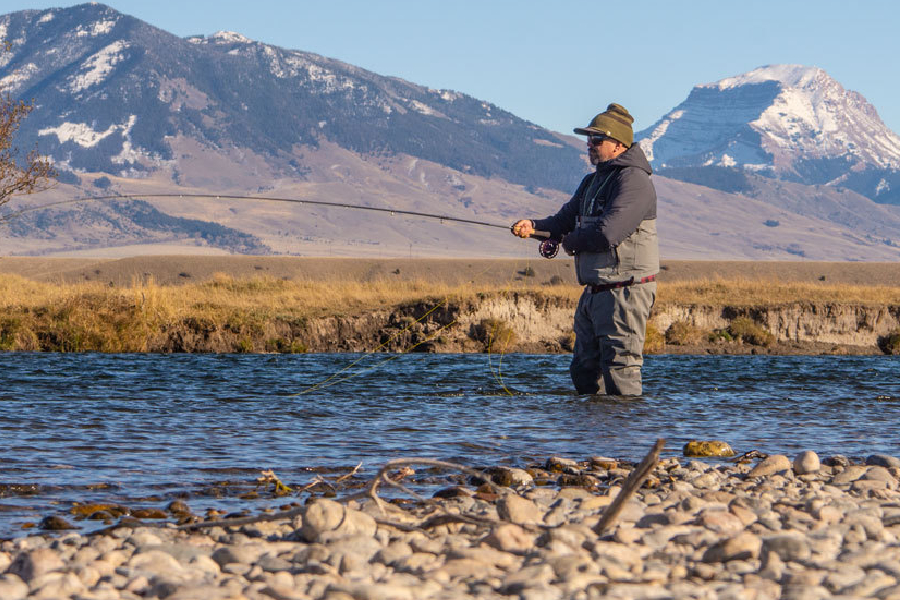It’s Sunday morning and the wind is blowing around 25 mph.
The wind chill is making a 30-degree day feel close to bare bones 0 outside.
Yeah, I’d agree. Either stay in bed or enjoy a hot cup of coffee. But what
about those days peaking 35 degrees and up with minimal wind? Now we’re
talking. It’s always tough staying motivated to fish in the Winter. Lately, the
weather has been a roller coaster snow one day, 40 mph gusts the next, and
all to be topped off by a balmy 40-degree day with clouds and rain. Theresa’s a
method to Winter fly fishing. I have a system that I compare to a misery index
crossed with cost effectiveness. It equates to a pretty accurate statement. How
miserable am I prepared to be in these conditions to maybe catch some fish? Fly
fishing the short days of Winter can be rewarding, but the most rewarding thing
of all is that it will make you a much better angler overall. I’ll tell you the
secrets to making Winter fly fishing your new favorite time of year to get on
the water
Focus On the Weather
This isn’t necessarily for your own comfort, though it can
really motivate you to get out if the weather is nice. On an average day of
fishing, it is definitely important to hit the water at the peak of the day,
especially if it’s sunny. However, the key to hitting a great day of fishing is
watching fronts, pressures, and temperatures and how they relate to the fish.
Sometimes a 40-degree plus drizzly winter day can have a higher misery index,
but it may have a high cost effectiveness. The barometer affects
macroinvertebrates more than we realize, thus affecting the trout. It’s all
about food availability and water temperature. A small drop in pressure can
increase bug activity, and a fraction of a degree or two can affect both bugs
and trout. This change equates to a mid-Summer cold rain that can shut off the
fishing except backwards. The same principle applies. Trends that I’ve recently
noticed are overcast days that are unseasonably warm predating a cold snap or
front bringing snow and wind. I’m sure there’s a much more scientific term for
these periods, but I prefer to stick to being a trout bum, not a meteorologist.
40-50-degree drizzly days in Winter are one of my favorites. In my opinion,
rain or shine, a day above 40 is worth a try in the heart of Winter.
Freestone, Limestone, or Tailwater? Choosing the Water
The source of the waterway you fish dictates the Winter
fishery in more ways than just temperatures. Alkalinity, substrate, and
geography heavily influence factors in a river system. Alkalinity and overall
nutrient load heavily influence the nutrient chain which influences the productivity
of aquatic insects. On many spring or limestone streams, we have a good
nutrient balance which can sustain macroinvertebrate life. Paired with
consistent temperatures from the source, bug life can be supported below the
surface in high capacity, creating for great Winter fishing. Tailwaters work in
a very similar manner. Bottom release dam systems release a consistent and
insulated temperature water from the hypolimnion, which will generally remain a
consistent temperature for a way downstream of the release point. Spring creeks
and tailwaters get the hype for winter fishing rightfully so. However, many
freestone streams have isolated areas where Winter trout will hang out. Often
you may find a seep or small bankside spring flowing into the system. Not
large enough of an impact to influence the system, but that localized area can
be an incredible source to hold a pretty heavy concentration of fish in the
winter. Lastly, substrate often gets overlooked in freestone systems. Different
substrates insulate heat better than others. This is often a daily up-down
trend, but can influence activity during the peak of the day. Often geologic
structures such as mountains and canyons can shade a system which will reduce
the water’s ability to warm effectively. Keep these things in mind when you are
selecting a Winter fishery.
Condense Your Fly Selection
Don’t make the mistake of spreading yourself thin. Hatches
can be extremely small, insignificant, or non-existent on many rivers. Know
what Winter bugs are on your water. Focus on those. I rotate between maybe 5
flies in the Winter, and that’s about the end of it. I know it’s cliched, but
to catch a fish, think like a fish. There aren’t many big bugs tumbling down
river in the heart of winter, less the occasional stonefly on western rivers.
Here’s my top 5 patterns and why.
A.
Perdigon Nymph Nobody knows what
exactly it imitates, and I think that’s the point. It’s a rough outline and
profile of just about any smaller aquatic insect. They are heavy, they have a
neat segmented look to them, and they’re small. Fish are less picky with
smaller bugs. If you don’t have 10-20 in your Winter-box – get on it!
B.
Walt’s Worm One of my favorite flies
for any tailwater or spring fed system, they can imitate anything from sow bugs,
scuds, cressbugs, to small caddis pupae. In the right sizes and colors,
imitating a small mayfly nymph isn’t a crazy idea. I often fish these with a
hot bead in the Winter months.
C.
Zebra Midge Any midge with white,
silver, red, or green rib will be found in my box. Midge larva are extremely
hardy, often hatching in close to freezing water on days where the air
temperature is above freezing. This fly compliments great on a tandem rig.
However, its small size makes it a great single when sight fishing trout in
more technical situations.
D.
Pheasant Tail Nymphs Rarely will I not
fish a PT on a rig. I like to tie my PTs on size 14-18 scud hooks. This matches
a small mayfly size such as a Blue Winged Olive, which can be common
sometimes throughout the winter. I will use tungsten beads and hot beads,
though unweighted ones are great for technical situations in shallower water.
E.
Hanging Midge Surprisingly, I don’t
often use this fly. However, it’s like a fire extinguisher rather have than
not need than need and not have. So many times, have I viewed trout just
sipping and tailing like crazy in the middle of January and February. Sometimes
a size 20-24 is just what they are looking for. This is a dry/emerger that I
will fish on the surface or just below. Let me tell you, Winter fish on the
surface cannot be beat.
Long story short, keep it simple and don’t get caught up on
predicting a hatch. Most of the time trout cannot afford to be picky in the
winter.
Rethink Your Technique and Rigs
I know I just listed a bunch of small flies without even
making a peep about streamer fishing. I bring this up, because lots of guys
pound the heck out of water with oversized bugs this time of the year.
Occasionally you’ll move a couple of nice fish on big articulates for sure.
However, my best experiences are dead drifting small streamers or fishing them
low and slow. When I mean small, I’m talking size 6 and 4 on average. A lot of
these patterns are simple leech or sculpin patterns, nothing special. It’s more
about speed and the fishes activity level. I carry the same mentality with
nymphing. I’m bit by the tight-line or Euro-style method. It’s a great and
effective way to hammer on some slow moving held-up trout. With flies that are
in contact with the bottom, they are generally right in the fishes zone. Which
such a linear presentation, tight lining if often done by covering the first
few feet of a hole, and reaching out to the other side of the hole along a seem
or run. The idea here is that as you work across, you are likely passing within
a foot or less of fish across your target area, ideal for slow moving or slow
feeding trout. This time of the year trout will generally not move far for
food, except some occasional situations where bugs may be plentiful along a
warmer current. Understanding that trout will not move far for food, this
brings me to the last point, and in many ways, one of the most important.
Learn to Read the Water
Spotting likely lies for Winter trout can be tough, and it
can vary from river to river. I’m going to use the Madison River in Montana as
a prime example. To the untrained eye, the river can look like one consistent
riffle, and the general depth in the winter is pretty shallow. So, how do we approach
such a river? Wave lines. These are the highest flow areas of the river, and
often confused with riffles. They will have a greater distance between each
wave and have a relatively high volume moving through. Some wave lines will
hold trout, but due to the hydraulics trout will hold off to the edges if there
is slower water available. Avoid wasting your time fishing directly in these
quick sections during the winter. The key is finding where food is available to
the fish with minimal effort. Buckets. Buckets form in a lot of different
areas, but on the Madison, buckets seem to pop up randomly throughout shallow
riffles and adjacent and below these larger wave lines. A bucket is simply a
depression in the bottom that stalls the undercurrent forming a slow pocket
that collects food and trout. Fast water may still rush over the surface, so
beating the flies through the swift surface current is essential. Seams and
Diamond Chop. Diamond chop looks like a bunch of little triangles poking at the
surface of the water. This is caused by rougher water at the edges. However,
where the diamond chop is, there is a seam, or section of slower moving water
between two major currents. Some seams are virtually still as the current
rushes past both sides. This offers trout a prime location to sit and feed with
minimal effort. If you could sit on the couch, watch football, and eat wings
all day would you? That’s kind of how trout prioritize their wintertime needs.
There’s a lot more to Winter fly fishing than just the above
statements, however, getting out and experiencing it first hand coaches you
along the way. The big picture is, don’t expect to hurl out an indicator with
some nymphs and expect to just catch fish. Patterns change with the weather and
the season, so our train of thought and our mentality must follow suit. I bet
if you start to become proficient and understanding the timing and location of
Winter trout, you will have some awesome days of fishing that may rival some of
your summer days on the water.




